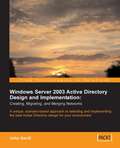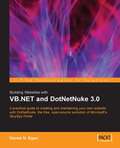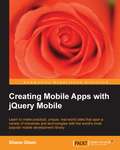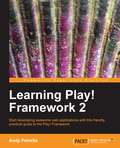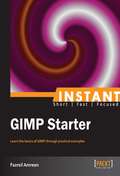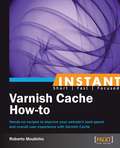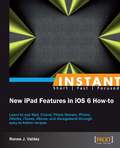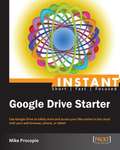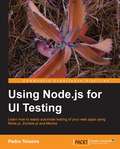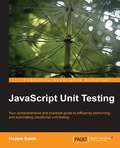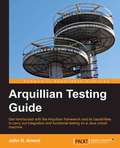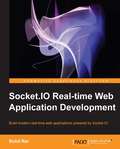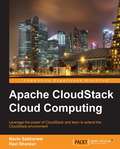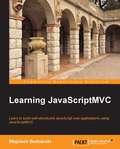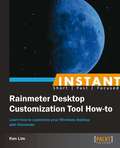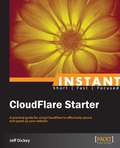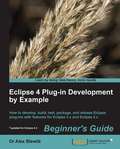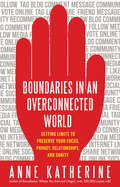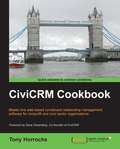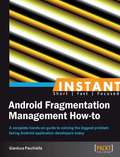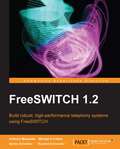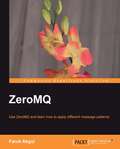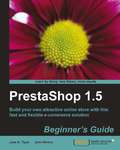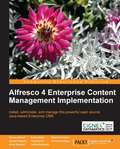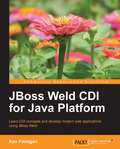- Table View
- List View
Windows Server 2003 Active Directory Design and Implementation: Creating, Migrating, and Merging Networks
by John SavillThis book is for Windows network administrators, analysts, or architects, with a grasp of the basic operations of Active Directory, and are looking for a book that goes beyond rudimentary operations. However, all of the concepts are explained from the ground up, and the book can be read by network design and administration professionals with no prior Active Directory knowledge.
Building Websites with VB.NET and DotNetNuke 3.0
by Daniel N. EganYou can use this book to help you set up and administer a DotNetNuke portal, even if you have a limited knowledge of ASP.NET. You will learn how to setup and administer an example site, stepping through all the tasks to ease your learning. If you are a developer, this book will help you extend the DotNetNuke portal by first helping you understand how the core framework works and then show you how to create custom modules and skins. A rudimentary knowledge of VB.NET programming is assumed, but the emphasis is not on becoming a better VB.NET programmer but on taming DotNetNuke. This book has been written for both the beginner wanting to set up a website and also ASP.NET developers with a grasp of VB.NET and access to Visual Studio .NET. No prior knowledge of DotNetNuke is assumed. The new features of DotNetNuke 3.0 are discussed extensively, so even if you have worked with previous versions of DotNetNuke, you will find something new.
Creating Mobile Apps with jQuery Mobile
by Shane GliserWith ample coded examples and screenshots, the book consists of 10 different projects that will help you master jQuery Mobile. "Creating Mobile Apps with jQuery Mobile" assumes a base level knowledge of web development. If you've used jQuery Mobile before, you're gold. Otherwise, you can pick it up along the way.
Learning Play! Framework 2
by Andy PetrellaA strong focus is placed on explanation by example; even with the amount of amazing capabilities of Play! 2, they will be gathered in a single application. At the end of this book, the reader will have a fully-fledged application using the basic and advanced features of Play! 2. Readers must be interested in the Web in general; specifically using the HTTP between a browser and a server to create blazing projects! Java skills are beneficial but not necessary since Play! Framework 2 is not J2EE based but introduces a simple, neat, and completely integrated version; the prerequisites are almost none.
Instant GIMP Starter
by Fazreil AmreenA Starter guide which helps you practically start with GIMP through plenty of examples and screenshots. This is an excellent handbook for anyone who would like to start drawing using their computers. The approach used within this book is objective so that readers from any age will be able to learn the process. The setup is so basic that you will need only a computer and a very minimal amount of computer literacy to start using this book.
Instant Varnish Cache How-to
by Roberto MoutinhoFilled with practical, step-by-step instructions and clear explanations for the most important and useful tasks. Get the job done and learn as you go. Easy-to-follow, step-by-step recipes which will get you started with Varnish Cache. Practical examples will help you to get set up quickly and easily.This book is aimed at system administrators and web developers who need to scale websites without tossing money on a large and costly infrastructure. It's assumed that you have some knowledge of the HTTP protocol, how browsers and server communicate with each other, and basic Linux systems.
Instant New iPad Features in iOS 6 How-to
by Renee J. ValdezA how-To book with practical recipes accompanied with rich screenshots for easy comprehension. "The New iPad: Using New Features in iOS 6 How-To" is for anyone somewhat familiar with an iPad but wanting to get an overview of its new features. A basic understanding of touch devices is good but not necessary. The recipes walk you through everything you need to know to accomplish each task. Good for the novice and the expert, there's something in here for everyone.
Instant Google Drive Starter
by Mike ProcopioThis book is a Starter which teaches you how to use Google Drive practically. This book is perfect for people of all skill levels who want to enjoy the benefits of using Google Drive to safely store their files online and in the cloud. It's also great for anyone looking to learn more about cloud computing in general. Readers are expected to have an Internet connection and basic knowledge of using the internet.
Using Node.js for UI Testing
by Pedro TeixeiraFull of techniques and tips for simulating user interactions and verifying that your application is behaving correctly.This book is for frontend and backend web application developers that know how to program in JavaScript.
JavaScript Unit Testing
by Hazem SalehA practical, example-driven guide to using, automating, and integrating JavaScript Unit tests for the busy and conscientious JavaScript developer striving for excellence and success. JavaScript Unit Testing is a must have guide for every web developer, designer, architect, and JavaScript coder seeking to ensure the highest quality of their web applications and JS code. Knowledge of JavaScript is assumed.
Arquillian Testing Guide
by John D. AmentThis book is a tutorial filled with plenty of code examples and strategies to give you many options when building your test structure.This book is for developers and testers alike. Anyone who has worked with test driven development or building automated test cases will find use in this book. A reader should be familiar with some automation strategies and techniques such as JUnit and should have some exposure to techniques such as mocking.
Socket.io Real-time Web Application Development
by Rohit RaiWritten in an engaging, easy-to-follow style, "Socket.io Real-time Web Application Development" is a practical guide for developing real-time web applications with Node.js and socket.io.This book is aimed at developers who want to start developing highly interactive and real-time web applications like chat systems or online multiplayer games, or want to introduce real-time updates or server push mechanisms in their existing applications. Knowledge of developing in JavaScript and web applications in general is expected. Though there is a chapter on introducing Node.js, prior knowledge of Node.js will be a plus.
Apache CloudStack Cloud Computing
by Navin Sabharwal Ravi ShankarThis book is packed with practical, hands-on illustrations for building and managing your CloudStack environment.If you are a cloud architect, cloud administrator, virtualization administrator, cloud storage administrator, cloud computing professional, or technical evangelist who is looking to learn and leverage CloudStack, then this book is for you. You will learn how to set up a cloud service for your enterprise or for your customer.
Learning JavaScriptMVC
by Wojciech BednarskiLearning JavaScriptMVC is a practical guide to learn about developing web applications with JavaScriptMVC.This book is for anyone who is interested in developing small- and mid-size web applications with the JavaScriptMVC framework, which is based on the most popular JavaScript library - jQuery.Readers should be familiar with JavaScript, browser APIs, jQuery, HTML5, and CSS.
Instant Rainmeter Desktop Customization Tool How-to
by Ken LimFilled with practical, step-by-step instructions and clear explanations for the most important and useful tasks. A short, concise book focused on delivering immediate results with practical recipes on customizing your desktop.This book is geared towards PC users with sufficient working knowledge of Windows. You should be comfortable with surfing the Web, and downloading and manipulating files on your desktop to start with. We will provide you with the rest.
Instant CloudFlare Starter
by Jeff DickeyWritten as a practical guide, CloudFlare Starter will show you all you need to know in order to effectively improve your online presence in a multitude of different ways."CloudFlare Starter" is a practical yet accessible guide for website owners looking to optimize their site for optimum security and maximum performance.
Eclipse 4 Plug-in Development by Example Beginner's Guide
by Dr Alex BlewittA Beginner's Guide following the "by Example" approach. There will be 5-8 major examples that will be used in the book to develop advanced plugins with the Eclipse IDE.This book is for Java developers who are familiar with Eclipse as a Java IDE and are interested in learning how to develop plug-ins for Eclipse. No prior knowledge of Eclipse plug-in development or OSGi is necessary, although you are expected to know how to create, run, and debug Java programs in Eclipse.
Boundaries in an Overconnected World
by Anne KatherineOver the past decade, 24/7 connectivity has given us not only convenience and fun but worries about privacy, interruptions while working or trying to enjoy family or other downtime, and new compulsions -- from shopping to tweeting and cute-cat watching. Anne Katherine, one of the authors who brought boundary setting to a mass audience, has now written a book on how to set healthy boundaries with technology. The first of its kind, this resource doesn't suggest anyone go "cold turkey." Instead, it helps people make social media, smart phones, and other innovations work for, rather than against, them. Readers learn to protect themselves online in every way -- from predators and data mining as well as time-devouring friends and acquaintances -- with an emphasis on preserving and optimizing meaningful personal connections. Anyone who has ever wondered if their cute little gadget was actually an enemy invader will welcome Katherine's strategies for ensuring "that your life is truly your own."
CiviCRM Cookbook
by Tony HorrocksThis book is written in cookbook style with practical, comprehensive recipes expained with the aid of the necessary screenshots.If you have basic CiviCRM skills and want to further enhance your CiviCRM skills, this book is for you.
Instant Android Fragmentation Management How-to
by Gianluca PacchiellaWritten in the easy to understand Packt How-to format, this book offers the solution to the big issues in Android application development. If you want the best possible reviews for your apps, regardless of device or Android operating system, then this book is for you.
FreeSWITCH 1.2
by Raymond Chandler Michael S Collins Darren Schreiber Anthony MinessaleThis book is full of practical code examples aimed at a beginner to ease his or her learning curve.This book is written for IT professionals and enthusiasts who are interested in quickly getting a powerful telephony system up and running using the free and open source application, FreeSWITCH.Telephony experience will be helpful, but not required.
ZeroMQ
by Faruk AkgulA practical, step-by-step example-rich tutorial.If you are a C developer who wants to learn about ZeroMQ, this book is for you. It is assumed that the reader has C experience at some level but prior ZeroMQ knowledge is not expected.
PrestaShop 1.5 Beginner’s Guide
by John Horton Jose A. TizonThis book is written in a friendly voice with lots of tips, tricks, and screenshots to help you set up, extend, and personalize your own online shop. If you want to start your own e-commerce business, then this book will help you do that.This book is for people who are interested in creating an online shop. Basic HTML and CSS skills would be beneficial but are not required as we will provide you with all the code and know-how you need.
Alfresco 4 Enterprise Content Management Implementation
by Munwar Shariff Snehal ShahThis book distils the hands-on approach of the training courses into a concise, practical book. The emphasis is on getting up and running fast and discovering the scope and power of Alfresco 4 incrementally through practical examples. Though this book is not a developer guide, various examples in the book will help developers to extend Alfresco functionality and to integrate Alfresco with external systems.This book is designed for experienced users, business owners, or system administrators who want to install and use Alfresco in their teams or businesses. Because Alfresco is free, many teams can install and experiment with its ECM features without any upfront cost, often without management approval. You need to have a degree of technical confidence, but you do not require specialist system admin or developer skills to get a basic system up and running.Though this book is not a developer guide, various examples in the book will help you to extend Alfresco functionality and to integrate Alfresco with external systems.
JBoss Weld CDI for Java Platform
by Ken FinneganThis book is a mini tutorial with plenty of code examples and strategies to give you numerous options when building your own applications."JBoss Weld CDI for Java Platform" is written for developers who are new to dependency injection. A rudimentary knowledge of Java is required.
